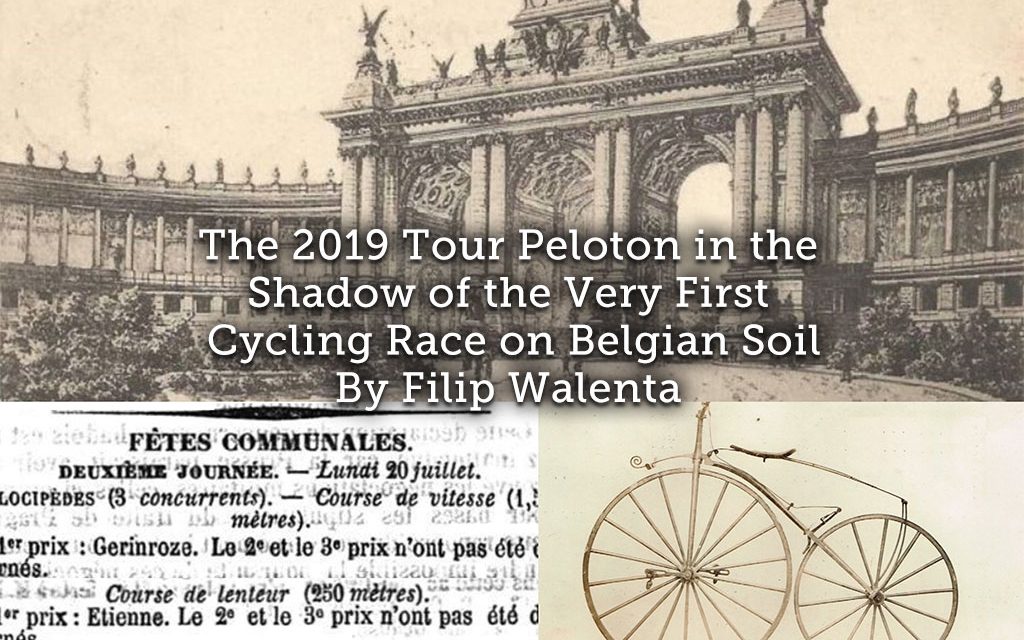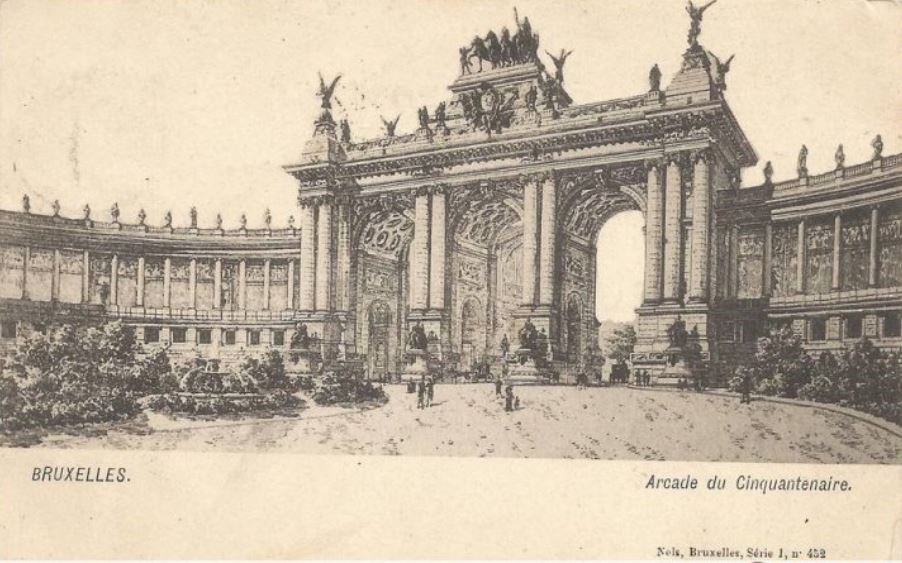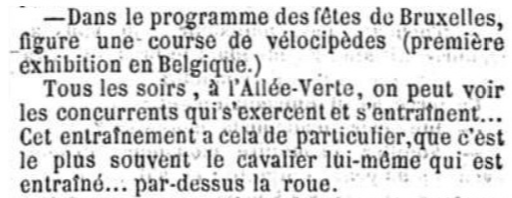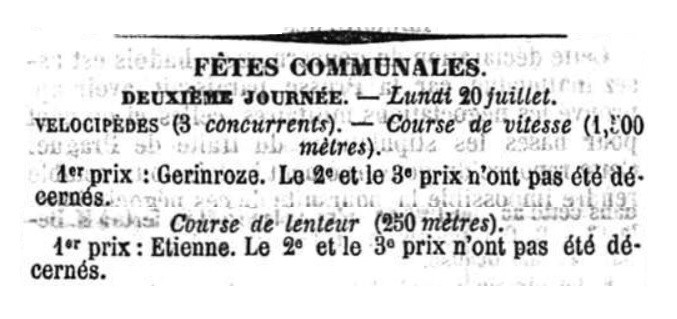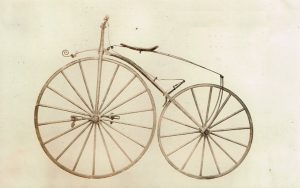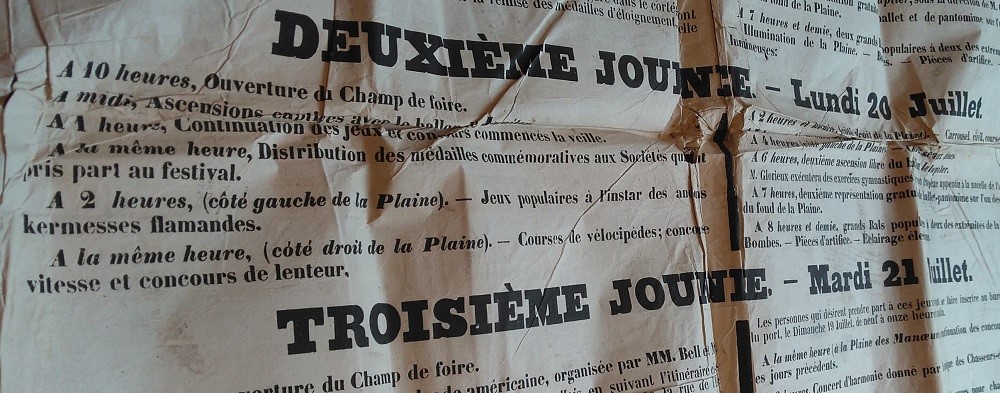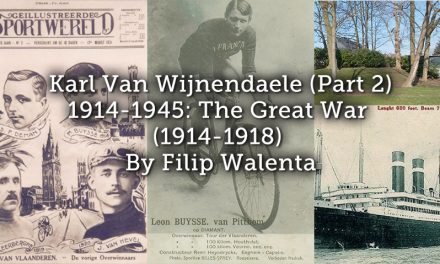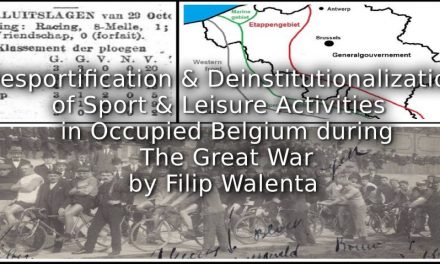On Saturday, July 6 the 106th edition of the ‘Grand Départ’ will start at the Atomium monument in Brussels to the honor of the first Tour victory in 1969 of Eddy Merckx, who is considered as the most successful rider of competitive cycling. After a lap of 192 kilometers over hilly terrain with several famous climbs of the Tour of Flanders like the Muur van Geraardsbergen and the Bosberg the first stage will return to Brussels and finish near the Royal Palace of Laken.
The Karelvanwijnendaele.be project regularly studies the roots of the cycling sport and found in the online archives of the Royal Library of Belgium clues that the first cycling competition on Belgian soil also took place in Brussels. More than that, without knowing the organizers of the Tour coincidentally made a road map that sends the peloton during its last kilometers along the same place where 151 years ago the very first official cycling race was organized.
The very first cycling races ever were organized in Paris on May 31, 1868 in the Saint-Cloud Park at a stone’s throw of the Bois de Boulogne. The first race of that day was won by Polocini, the second by James Moore who was born in Bury St Edmonds, West Suffolk in 1849 but had moved to Paris with his family at the age of four. The following year he would win the first interurban cycling race Paris-Rouen.
There is an old Flemish expression that ‘If it rains in Paris, it drizzles in Brussels’, referring to the short distance between the two capitals and the close relationship the two cities used to maintain. Consequently it could not take long before in Brussels the first cycling race would take place. The best opportunity to show this new phenomenon to the general public was about to happen during the coming summer months.
In the spring of 1868 some civilians and coworkers of the administrative services of the city had the idea to breathe new life into the municipal fair. The festivities were planned during the period of the Belgian Independence Day at July 21, from Sunday July 19 till the following Sunday. An event of such scale needed a lot of space, so the choice for a large piece of wasteland East of the former city walls was quickly made. It was used as a training area by the army and was called the Champ de Manoeuvres.
- In the Champ de Manoeuvres a city park was build in 1880 commissioned by King Leopold II, later named the Jubelpark.
The organization spared no expenses to run the event smoothly, it had to become an exceptional spectacle in the image of the Flemish fair that used to attract thousands of day tourists to the capital. On the thirty four hectare terrain hundreds of booths and beer tents were set up. Special pavilions and tribunes were constructed for King Leopold II, his wife Maria Hendrika of Austria and their entourage who regularly came to join the festivities.
On behalf of the first Belgian King Leopold I the famous architect Victor Besme had already drawn the plans to reconstruct the training field into a city park to the occasion of the fiftieth anniversary of the Belgian independence in 1880. Under surveillance of his young and ambitious son Leopold II it would be named the Jubelpark in 1888 and rebuild with triumph arches in 1905.
Dozens of attractions were organized every day like balloon flights, several gigs of choirs, dance groups, orchestras, marching bands and several military parades. The cavalcades of ‘the Holy Sacrament’ and the local ogres went through the streets, and the American circus of Bell & Myers almost daily organized a parade with their wild animals into the inner city of Brussels. At night the festivities were continued with People’s Balls and dance halls that mostly ended with fireworks.
- The first announcement of the cycling race in La Meuse [01.07.1868]
Next to the traditional sporting events like archery, rifle shooting, fencing, pony and horse racing for the first time in Belgium also two cycling races were organized. Undoubtedly just like in Paris informal cycling races had been organized before but these races were the first to be organized by a higher authority and officially announced, open to every competitor by pre-registration, with a predetermined prize-pool and of which the results appeared in the local press a couple of days later. For the first three finishers of each race there was a prize. The winners got an artwork valued at 150 Belgian francs and a gold-plated medal, the second also a gold-plated medal and the third a silver plated medal.
The journal Le Bien Public reported that the participants were training each day near the Royal Palace and the Liège journal La Meuse mentioned that the best cyclists of Paris were registered and called on all their citizens to defend the national honor.
- Results of the cycling races in L’Echo du Parlement [21.07.1868]
The two races took place on Monday July 20 during the afternoon in the Champ des Manoeuvres but with moderate success as only three participants turned up. The first race was a speed race over a distance of 1500 meters and won by Gerinroze, the second was a slow race over 250 meters, won by a certain Etienne. At both races only the winner got his prize, the other participants probably crashed and were not mentioned in the race results.
- Michaux velocipede
Most likely the athletes drove on a Michaux velocipede, named after the inventor Pierre Michaux and better known as the boneshaker. The Michaux cycles had a thin metal frame, wooden wheels and fixed pedals on the axis of the front wheel. A similar new machine easily cost 300 Belgian francs, while an average workman in 1870 earned about 600 Bef per year.
On Saturday July 6, 2019 the first stage of the Tour de France finishes near the Royal Palace of Laken. During the last kilometers the peloton will rush to the finish line via the tunnel underneath the Jubelpark, where 151 years ago the very first cycling race took place.
At this stage the research of the first official cycling race in Belgium has not seen the end of it, as it turns out that also the municipal fairs of that period were un-investigated until now. In the mean time Pieter-Jan Lachaert, archivist-in-chief of the municipal archive of Ghent, has found overwhelming proof about the festivities and the cycling race in particular during his visit to the Brussels archive with several announcements, reciprocal mail between the Brussels city council and organizers, posters, etc.
Article © Filip Walenta

